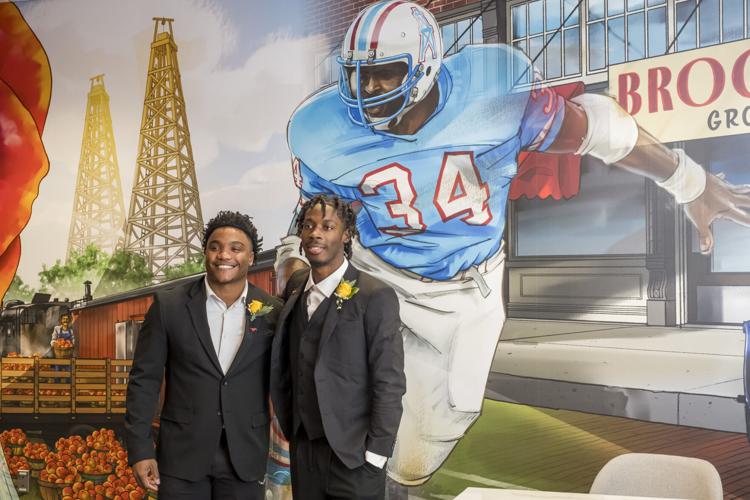
In the world of college football, there have been many names that stand out as legends. From Doak Walker to Herschel Walker, from Jim Thorpe to Bo Jackson, collegiate football history is filled with names that have transcended the game. However, one name that consistently comes up in discussions of the greatest to ever play at the college level is Earl Campbell. Recently, reports have surfaced that Earl Campbell has been named the best collegiate football player of all time, a distinction that solidifies his place as one of the most dominant figures in the sport’s history.
Campbell, often referred to as “The Tyler Rose,” left an indelible mark on college football with his combination of power, speed, and athleticism. His rise to stardom at the University of Texas in the late 1970s and early 1980s made him a household name. His selection as the greatest college football player of all time is a recognition of his unparalleled impact on the game. But what makes Campbell stand out among other legends of the sport, including notable figures from Georgia’s football history, like Herschel Walker?
Early Life and Rise to Fame
Born on April 29, 1955, in Tyler, Texas, Earl Campbell’s story is one of humble beginnings and a remarkable journey to the top. Raised in a working-class family, Campbell’s athletic ability was evident from a young age. His size and strength were immediately noticeable, and his high school football career at John Tyler High School was where he first began to make waves in the football world.
By the time Campbell arrived at the University of Texas in 1974, he had already established himself as a force to be reckoned with. Texas was known for its powerhouse football program, but Campbell quickly became the centerpiece of its offense. He was a running back who combined speed, agility, and brute strength in ways that were almost unprecedented for his size.
College Career at Texas
Campbell’s time at the University of Texas was a period of dominance. In his sophomore season (1975), he led the Longhorns to a national championship game, solidifying his place as one of the premier players in college football. But it was in his junior and senior years that Campbell truly cemented his legacy.
In 1977, he won the prestigious Heisman Trophy, awarded to the best player in college football. Campbell’s 1977 season was nothing short of remarkable, as he rushed for 1,744 yards and 19 touchdowns. His performance on the field was a masterclass in running back play. With a combination of vision, explosiveness, and power, he was nearly impossible to stop. His physicality set him apart from his peers; he was a player who could bulldoze through defenders and outrun others with ease.
Campbell’s success wasn’t limited to individual accolades. He helped Texas become a national powerhouse, leading the team to multiple bowl games, including the 1978 Cotton Bowl. Throughout his college career, Campbell amassed over 4,000 rushing yards and 40 touchdowns, numbers that were unheard of for the time.
The Unstoppable Force
What truly made Earl Campbell a phenomenon in college football was the way he was able to dominate at a time when defenses were becoming increasingly sophisticated. College football in the late 1970s and early 1980s featured some of the best defenses the sport had ever seen, yet Campbell was virtually unstoppable. His unique blend of speed, power, and vision made him a nightmare for opposing defenses.
At 6’1″ and 230 pounds, Campbell was a physical specimen. His ability to break tackles and run over defenders set him apart from other running backs of his era. While many players of his size might have been limited to a power-running style, Campbell’s combination of quickness and elusiveness meant he could excel in any part of the field. Whether it was running between the tackles or bouncing it to the outside, Campbell was a threat to score every time he touched the ball.
Perhaps one of the most iconic plays of his college career came during the 1977 Cotton Bowl when Campbell rushed for 197 yards and scored four touchdowns. His performance in that game encapsulated everything that made him great: power, speed, vision, and the ability to perform under pressure. He carried the Longhorns to a dominant victory over the University of Notre Dame, a team that was among the best in the nation at the time.
Comparing Campbell to Other Greats
Earl Campbell’s place as one of the greatest college football players is often discussed in comparison to other legends of the game. Among these is Herschel Walker, the great running back from the University of Georgia who is often mentioned in the same breath as Campbell when discussing the best collegiate players of all time. Walker, like Campbell, was a player who revolutionized the running back position with his combination of size, speed, and vision.
Walker won the Heisman Trophy in 1982 after a remarkable career at Georgia that saw him rush for 5,259 yards and 49 touchdowns. Walker’s power running style, combined with his speed, made him a dual threat that opposing teams struggled to contain. Like Campbell, Walker was a physical force who could dominate on the ground and change the course of a game with a single play.
However, when it comes to comparing Campbell to Walker, many argue that Campbell’s combination of pure power and speed was more impressive, especially considering the era in which he played. While Walker had an incredibly successful college career, Campbell’s dominance during his time at Texas and his ability to perform on the biggest stages set him apart.
Other players such as Bo Jackson (Auburn), Jim Brown (Syracuse), and Barry Sanders (Oklahoma State) are often brought up in these discussions. Each of these players brought a unique skill set to the table, but Campbell’s blend of physicality and athleticism was something rarely seen before. His Heisman victory, coupled with his impact on Texas football, gives him a case as the greatest to ever play at the collegiate level.
The Impact on College Football
Earl Campbell didn’t just break records during his college career; he changed the way people viewed the running back position. His power and physicality set the tone for future generations of running backs, and his success helped elevate Texas to one of the most storied football programs in history.
Campbell also became a cultural icon. His performances at Texas were followed closely by fans across the country, and his humble persona endeared him to millions. He was a hero in Texas and an inspiration to players everywhere. His legacy extended beyond his college days as he went on to have a successful career in the NFL, but it was at Texas where Campbell truly made his name.
A Legacy Cemented
Earl Campbell’s selection as the greatest collegiate football player of all time is not just a testament to his athletic prowess but also to his lasting influence on the sport. His time at the University of Texas remains one of the most dominant stretches of college football ever witnessed. His blend of speed, power, and vision made him nearly unstoppable and helped him to shatter records, win awards, and capture the hearts of fans everywhere.
While players like Herschel Walker, Barry Sanders, and Bo Jackson certainly have their place in the pantheon of college football greats, Earl Campbell’s legacy stands as one of the most enduring in the sport’s history. His impact on the game of football is undeniable, and his place at the top of college football’s Mount Rushmore is well-earned.





